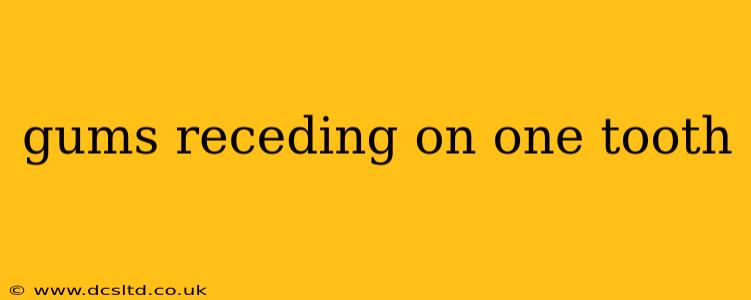Gum recession, where the gum tissue pulls back from the tooth, is a common dental problem. While it can affect multiple teeth, it's also possible to experience gum recession on just one tooth. This can be concerning, but understanding the causes, treatment options, and preventive measures is crucial for maintaining oral health.
What Causes Gum Recession on One Tooth?
Several factors can contribute to gum recession, even if it's localized to a single tooth. These include:
-
Aggressive Brushing: Brushing too hard or using a hard-bristled toothbrush can wear away the gum tissue over time. This is especially true if you concentrate your brushing on one specific area.
-
Gum Disease (Periodontal Disease): This is a major culprit. Bacteria build up, causing inflammation and infection that destroys the supporting tissues of the teeth, leading to gum recession. Even a localized infection can affect a single tooth.
-
Genetics: Some individuals are genetically predisposed to thinner gum tissue, making them more susceptible to recession.
-
Tooth Grinding (Bruxism): The constant pressure from grinding or clenching teeth can put excessive stress on the gum line, causing it to recede. This might be more pronounced on teeth that bear the brunt of the grinding.
-
Misaligned Teeth (Malocclusion): Teeth that don't fit together properly can put extra pressure on specific areas, contributing to gum recession.
-
Piercings: Oral piercings, particularly those near the gum line, can irritate the tissue and lead to recession.
-
Trauma: An injury to the mouth, such as a blow to the face, can damage the gums and cause recession.
How is Gum Recession on One Tooth Treated?
Treatment for gum recession depends on the severity and underlying cause. Options include:
-
Improved Oral Hygiene: If the cause is aggressive brushing, switching to a soft-bristled brush and gentler brushing techniques is crucial. Regular flossing is also essential to remove plaque and bacteria.
-
Periodontal Treatment: If gum disease is present, your dentist will perform scaling and root planing to remove plaque and tartar below the gum line. Antibiotics may be prescribed to combat infection.
-
Surgical Procedures: For more severe recession, surgical treatments may be necessary. These include:
- Gum Grafting: Tissue from another part of the mouth (usually the palate) is transplanted to cover the exposed root.
- Connective Tissue Graft: This involves taking connective tissue from beneath the gum line and using it to repair the recessed area.
- Guided Tissue Regeneration (GTR): This technique uses a membrane to promote the regrowth of gum tissue and bone.
Can Gum Recession on One Tooth Be Prevented?
Prevention is key. Here's how you can protect your gums:
-
Gentle Brushing: Brush your teeth twice a day using a soft-bristled toothbrush and fluoride toothpaste with gentle circular motions.
-
Regular Flossing: Floss daily to remove plaque and food particles from between your teeth.
-
Regular Dental Checkups: See your dentist for professional cleanings and examinations at least twice a year. Early detection and treatment of gum disease are essential.
-
Mouthguard: If you grind your teeth, wear a mouthguard at night to protect your teeth and gums.
-
Quit Smoking: Smoking significantly increases the risk of gum disease and gum recession.
-
Proper Nutrition: A balanced diet rich in vitamins and minerals supports overall health, including gum health.
What if I only see recession on one tooth, should I be concerned?
Yes, even if you only notice gum recession on one tooth, it's important to see a dentist. Early diagnosis and treatment can prevent further recession and potential complications, like tooth sensitivity, tooth loss, and even more extensive periodontal disease. Don't delay seeking professional dental care.
Is gum recession on one tooth a sign of gum disease?
Gum recession on one tooth can be a sign of gum disease, but it's not always the case. Other factors, as mentioned above, can also cause it. A dentist can determine the underlying cause through a thorough examination.
How long does it take for gums to recede?
The rate of gum recession varies depending on the cause and individual factors. It can be a slow, gradual process or a more rapid progression, especially if gum disease is involved. Regular dental checkups are crucial for early detection.
Remember, this information is for educational purposes only and does not constitute medical advice. Always consult with your dentist or a qualified dental professional for diagnosis and treatment of any dental concerns.
